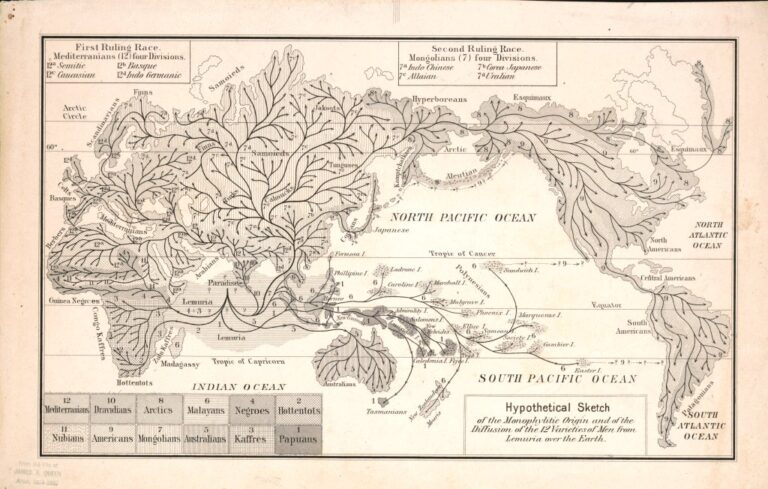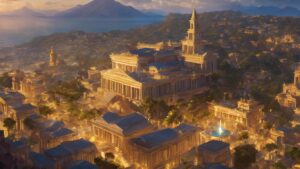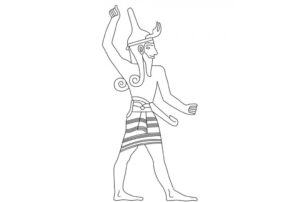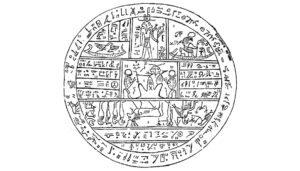Table of Contents
Lemuria, the enigmatic and mythical land, has captivated the imagination of explorers, scholars, and mystics for centuries. This legendary continent, believed to have once existed in the Indian and Pacific Oceans, is steeped in mystery, rich in lore, and shrouded in intrigue.
Origins
The naturalist and biologist Philip Sclater proposed the concept of Lemuria in the mid-19th century. He suggested a land bridge between Madagascar and India, naming it “Lemuria” after the lemurs found across the Indian Ocean. Sclater based his theory on the distribution of lemurs and other animals, implying a land connection.
Appearance
Lemuria, as a mythical place, is described through various imaginative and mystical lenses, leading to diverse and often fantastical portrayals. Here are some common descriptions:
Lush and Verdant Landscapes: Many envision Lemuria as a paradise with abundant greenery, featuring dense forests, exotic plants, and cascading waterfalls. This lush environment is often depicted as untouched and pristine, symbolizing natural beauty in its purest form.
Mountains and Crystal Formations: Frequently, descriptions of Lemuria include towering mountains and large crystal formations. Often, these crystals are portrayed as possessing mystical properties, enhancing the land’s enigmatic allure.
Advanced, Esoteric Architecture: Some accounts imagine Lemuria with advanced and mysterious structures, possibly made from unique materials or embodying esoteric designs. These buildings might suggest a civilization that had reached high levels of spiritual and technological development.
Alien Landscapes: In certain portrayals, Lemuria diverges significantly from familiar earthly landscapes, featuring alien terrains with unusual geological formations, perhaps glowing with ethereal light or exhibiting otherworldly characteristics.
Underwater or Sunken Aspects: In line with the myth of it being a sunken continent, some descriptions present Lemuria as an underwater realm, with remnants of its civilization hidden beneath the ocean waves, evoking a sense of mystery and lost history.
Harmonious Coexistence: Often, depictions of Lemuria show inhabitants living in harmony with nature, embodying peace, balance, and spiritual enlightenment ideals.
Mystical and Ethereal Atmosphere: There’s usually a sense of magic or mysticism associated with Lemuria, often depicted with a serene, otherworldly atmosphere that suggests a connection to higher spiritual realms.
Who Can Get There?
Access to Lemuria, if it indeed exists, has been a subject of speculation and debate. Some hold the belief that mystical means or altered states of consciousness are the only ways to reach Lemuria. Others contend that accessing this hidden realm requires advanced technology or secret knowledge.
Explorers
Throughout history, there have been numerous accounts of individuals who claimed to have visited Lemuria. These explorers and mystics have provided tantalizing glimpses into the mystical world.
Madame Blavatsky: The famous Russian mystic Madame Helena Petrovna Blavatsky claimed to have had contact with Lemurian beings through her spiritual writings. She described Lemuria as a highly advanced civilization with spiritual knowledge far beyond our own.
Edgar Cayce: The renowned American psychic Edgar Cayce also spoke of Lemuria in his readings. He described it as a place where souls were developed and progressed through various lifetimes.
Paulina Zelitsky: In 1999, Russian oceanographer Paulina Zelitsky claimed to have discovered underwater structures near Mauritius that she believed could be remnants of Lemurian civilization. However, these claims remain highly controversial.
New Age Explorers: In recent years, New Age enthusiasts and spiritual seekers have embarked on journeys to access Lemuria through meditation, astral projection, or guided visualization, claiming to have experienced its mystical beauty.
Myths and Stories
Lemuria transcends a mere physical location, encompassing realms of mythology and mysticism. Compelling myths and stories about this mythical lost continent include:
The Lemurian Seed Crystals: New Age beliefs tell of Lemuria housing spiritually advanced beings who left behind Lemurian Seed Crystals. These crystals allegedly contain the wisdom and energy of the mythical land, making them sought-after by crystal enthusiasts.
The Lemurian Scrolls: Some assert the existence of ancient Lemurian scrolls or texts, brimming with esoteric knowledge and spiritual teachings. Beliefs suggest these scrolls rest in hidden underground chambers or are under mystical beings’ guard.
The Lost Lemurian City of Telos: Modern New Age teachings claim Lemuria has a subterranean city, Telos, populated by advanced Lemurians. Legends propose mystical portals in Mount Shasta, California, as gateways to Telos.
The Fall: Various myths narrate Lemuria’s decline due to natural disasters or spiritual decay. There’s also a belief in the Lemurians’ advanced technology misuse causing their downfall, paralleling the Atlantis myth.
The Search Continues
Lemuria continues to be a subject of fascination and exploration. While mainstream science dismisses the idea of a lost continent in the Indian and Pacific Oceans, the allure of Lemuria persists in the realms of mysticism, spirituality, and fringe science.
In conclusion, Lemuria remains an enigmatic and captivating concept that has captured the human imagination for generations. Whether as a physical landmass lost to time or a mystical realm accessible only through inner consciousness, mythical land continues to inspire wonder, curiosity, and a sense of the unknown. As long as the mysteries surrounding Lemuria endure, explorers, mystics, and seekers will continue to seek its elusive secrets, adding to the tapestry of myths and legends that surround this mythical place.
FAQ
Where was Lemuria supposedly located?
Lemuria was theorized to be in the Indian or Pacific Ocean, connecting India and Madagascar.
Who proposed the idea of Lemuria?
The concept was first proposed by zoologist Philip Sclater in the 19th century.
Why was Lemuria hypothesized?
Sclater suggested Lemuria to explain the distribution of lemurs across the Indian Ocean.
Does Lemuria have a scientific basis?
No, modern science disproves Lemuria's existence, attributing lemur distribution to continental drift.
What are some myths about Lemuria?
Myths include it being home to advanced beings, holding mystical crystals, and a subterranean city named Telos.
Can Lemuria be visited?
According to myths, it's accessible through spiritual practices or consciousness but not physically.
Is Lemuria the same as Atlantis?
No, they are different mythical lands, but both share themes of advanced civilizations and destruction.




